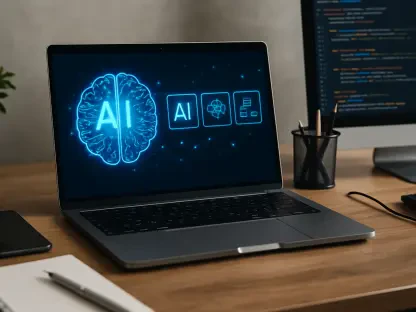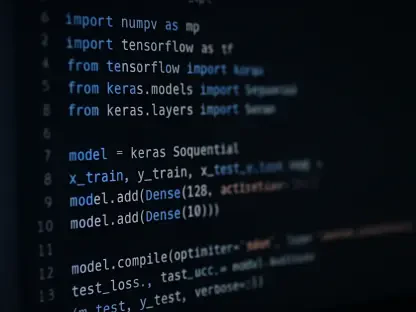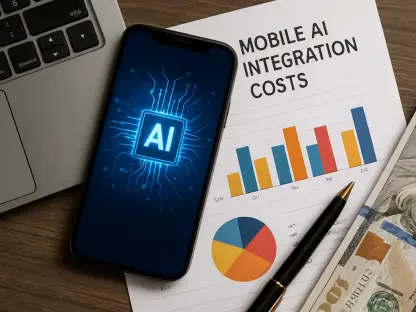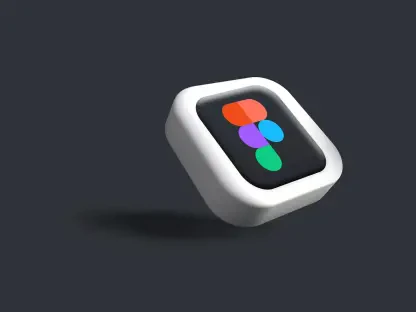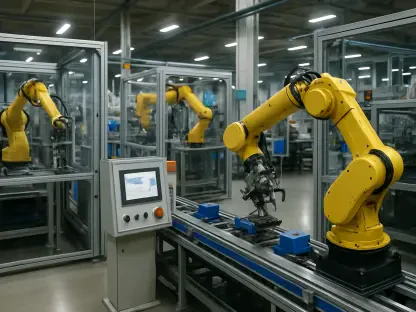Imagine a world where crafting stunning user interfaces takes half the time it used to, where developers can focus on creativity rather than wrestling with repetitive code, and where innovation thrives unhindered by mundane tasks. In 2025, this is no longer a distant dream but a tangible reality, thanks to the rapid integration of artificial intelligence into frontend development. The staggering statistic that 68% of developers save at least 10 hours weekly using AI tools underscores a seismic shift in how digital experiences are built. This review delves into the transformative power of AI tools, spotlighting their features, real-world impact, and potential to redefine efficiency in creating user interfaces.
The Emergence of AI in Modern Workflows
Artificial intelligence has swiftly moved from a peripheral curiosity to a cornerstone of frontend development. Initially seen as an experimental aid, AI now automates mundane tasks like boilerplate coding and layout adjustments, freeing developers to prioritize user experience and innovative design. This shift aligns with the broader tech landscape’s push for speed, where businesses demand rapid deployment of polished, responsive interfaces to stay competitive.
The significance of AI extends beyond mere convenience. It addresses the growing complexity of modern web applications, which often require seamless integration across diverse platforms and devices. By handling repetitive processes with precision, AI tools empower teams to meet tight deadlines without sacrificing quality, setting a new standard for development efficiency.
Spotlight on Leading AI Tools for Frontend Developers
GitHub Copilot: Your In-Editor Coding Companion
GitHub Copilot has become a go-to assistant for countless developers, embedding itself directly into popular IDEs like VS Code and WebStorm. Functioning as a real-time coding partner, it generates suggestions based on natural language prompts, often completing entire functions or debugging snippets before a developer even finishes typing. This capability drastically cuts down on manual input for routine tasks.
Its seamless integration ensures that frontend developers can maintain their workflow without switching tools or contexts. Whether crafting React components or refining CSS styles, Copilot anticipates needs with startling accuracy, often reducing coding time for small to medium tasks by significant margins. This efficiency is especially valuable in iterative projects requiring frequent updates.
AutonomyAI: Mastering Design-to-Code Automation
AutonomyAI pushes boundaries by offering advanced automation that converts design specifications from platforms like Figma or Jira into production-ready code. Unlike simpler tools, it grasps intricate project dependencies, ensuring that the output aligns with existing architectures and requirements. This makes it a powerful ally for complex, large-scale applications.
The tool’s ability to minimize manual intervention stands out in scenarios where design and development teams must collaborate closely. By automating the transition from mockups to functional code, AutonomyAI reduces errors and accelerates delivery timelines, proving indispensable for enterprises tackling multifaceted frontend challenges.
Cursor: Simplifying Code Optimization Through Conversation
Cursor enhances the familiar VS Code environment by introducing conversational AI capabilities that streamline project-wide modifications. Developers can input natural language requests, such as adjusting a component’s responsiveness across breakpoints, and Cursor executes these changes with precision. This intuitive approach transforms how routine optimizations are handled.
Its strength lies in making sophisticated edits accessible without deep dives into codebases. For frontend developers managing dynamic interfaces, Cursor offers a way to refine user interactions swiftly, ensuring that even last-minute tweaks maintain high standards of performance and aesthetics.
Google Stitch: Unifying Design and Development Seamlessly
Introduced as a groundbreaking solution at a recent Google I/O event, Google Stitch redefines the design-to-code pipeline by generating UI designs and corresponding code from text or image inputs. Integrated with Google’s ecosystem, including Android Studio and Firebase, it provides a cohesive experience for developers building across platforms.
This tool excels in bridging gaps between designers and coders, allowing for rapid iteration from concept to implementation. Its ability to interpret visual or descriptive inputs into functional interfaces positions it as a vital asset for teams aiming to prototype and deploy user-centric designs with minimal friction.
Locofy.ai: Accelerating Prototyping and Team Collaboration
Locofy.ai focuses on transforming static designs into operational code, supporting popular UI libraries and frameworks like React and Next.js. Its integration with GitHub facilitates smooth collaboration among team members, while flexible export options cater to varied project needs. This makes it a versatile choice for rapid prototyping.
The platform shines in environments where speed and teamwork are paramount. By automating the conversion of design assets into usable code, Locofy.ai enables frontend developers to focus on refining user flows rather than getting bogged down in initial setup, fostering innovation in tight schedules.
Trends Shaping AI-Driven Frontend Development
A notable trend in 2025 is the recognition of AI as a competitive necessity rather than an optional enhancement. The demand for faster, smarter workflows has pushed companies of all sizes to adopt these tools, ensuring they keep pace with market expectations. This shift reflects a broader industry acknowledgment that efficiency directly correlates with success.
Diversity in tool functionality also defines the current landscape, catering to specific developer pain points. From real-time coding aids to comprehensive design automation, AI solutions offer tailored approaches that address unique project demands. This customization ensures that whether a team needs quick fixes or end-to-end solutions, there’s a tool to match.
Another emerging focus is on contextual awareness within AI systems. Modern tools are increasingly adept at understanding codebases, design intents, and developer instructions, producing outputs that are not just functional but also relevant to specific use cases. This precision is key to maintaining quality in production environments.
Real-World Applications and Impact
Across industries, AI tools are being deployed to revolutionize frontend projects, from nimble startups crafting MVPs to enterprises overhauling legacy systems. These solutions enable rapid prototyping, as seen with Locofy.ai, which helps small teams turn concepts into testable products within days. Such speed is critical in gaining early user feedback.
For larger organizations, tools like AutonomyAI and Google Stitch manage intricate design integrations, ensuring consistency across sprawling digital ecosystems. Meanwhile, daily coding tasks benefit immensely from GitHub Copilot and Cursor, with developers reporting substantial time savings that allow more focus on strategic problem-solving over syntax struggles.
The tangible impact is evident in industry metrics, such as reports indicating developers reclaiming significant hours each week through AI assistance. This newfound time translates into deeper investment in user experience enhancements, driving innovation in how interfaces engage and retain audiences across digital touchpoints.
Navigating Challenges and Limitations
Despite their advantages, AI tools are not without hurdles. Over-reliance on generated code can lead to outputs that require extensive debugging or fail to meet the nuanced needs of bespoke projects. Developers must remain vigilant, balancing automation with manual oversight to ensure tailored results.
Technical barriers also persist, such as compatibility issues with less common frameworks or the initial learning curve associated with integrating AI into established workflows. These challenges can slow adoption for teams unfamiliar with tweaking tool settings or adapting to AI-driven processes.
Efforts to refine these technologies continue, with developers and vendors alike working to enhance adaptability and accuracy. Addressing diverse needs—whether through better framework support or more intuitive interfaces—remains a priority to ensure AI tools deliver consistent value in varied development scenarios.
Envisioning the Future of AI in Frontend Workflows
Looking ahead, AI is poised to become even more embedded in frontend development, potentially introducing advanced automation that handles entire project lifecycles with minimal input. Personalization of tool outputs could also evolve, tailoring suggestions to individual coding styles or project histories for unmatched precision.
Speculation points to breakthroughs in natural language processing, enabling even more nuanced interactions between developers and AI systems. Integration with emerging technologies like augmented reality interfaces might further expand the scope of what frontend tools can achieve, opening new frontiers in immersive design.
The long-term vision suggests a landscape where AI fosters intuitive, user-focused digital experiences across sectors. As tools grow smarter, their role in democratizing complex development tasks could empower a wider range of creators, reshaping how digital products connect with global audiences.
Final Reflections on AI’s Role in Frontend Innovation
Reflecting on this exploration, the journey through AI tools like GitHub Copilot, AutonomyAI, Cursor, Google Stitch, and Locofy.ai reveals a transformative force that redefines frontend development. Their capacity to save time, boost productivity, and streamline workflows stands out as a game-changer for developers navigating tight deadlines and complex projects.
Moving forward, the next step for teams is to strategically adopt these tools, identifying which solutions best align with specific project goals and team dynamics. Experimenting with a mix of in-editor aids and design automation offers a pathway to optimize efficiency while addressing unique challenges.
Beyond adoption, staying attuned to evolving AI capabilities emerges as crucial. Keeping pace with updates and exploring integrations with emerging tech promises to unlock even greater potential, ensuring that frontend development continues to push boundaries in delivering exceptional user experiences.


